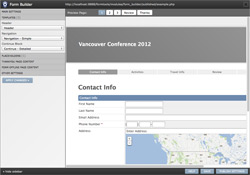Form Builder
Template Types
All about Template Types
Take a look at the screenshot to the right. It shows a form that was created with the Form Builder using the Default Template Set.
If you look at the form, you can see the page elements, just at a glance: you can see a header, a footer, the page fields, page title, some navigation and a block at the bottom where the user clicks "Continue". You may not be able to know where one section starts and ends, but you can get a general sense just by the way the page looks.
Template Sets work on this principle. They're comprised of individual Template Types, each used to draw a particular part of the page. When one of your published forms is displayed, the Form Builder pieces it together out of the selected Template Types.
To illustrate this, let's overlay the actual Template Set Template types through a little Photoshop trickery. The screenshot to the right shows the same page as before, except highlighting what markup is stored in what template.
As you can see, some template types are embedded within eachother. The "Page Layout" Template Type contains the Header, Footer and Page templates; the Page template (which is either a Form Page, Review Page, Thankyou Page or Offline Form Page template, depending on the context) contains the Navigation and Continue Block templates.
Defining Multiple Template Types
The Form Builder was designed to allow you to define multiple Template Types in a single Template Set. When this is done, the Form Builder then presents the user the option of choosing which template they wish to use. This lets you get a tremendous amount of use out of a single Template Set. For example, you could create five different Header Template Types. Then, when using the Form Builder to publish a new form, you could pick whatever Header you want to use.
To further re-inforce this point: if you look at the screenshot to the right, it shows the Form Builder window with the "TEMPLATES" panel open on the left. Notice that there are three different Template Types that may be selected. This is because each of those Template Types has more than one Template Type defined in the Template Set. If there's only one of a Template Type defined, it won't display it - because there's no point! That Template Type would have to be used when generating the form.
This helps keep the Form Builder interface as uncluttered as possible, and only presents the user with as much information as they really need.
The following sections discuss each of the template types.


